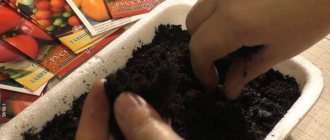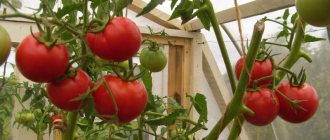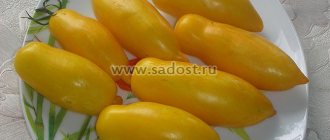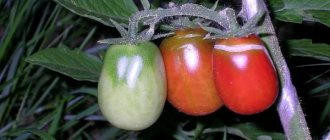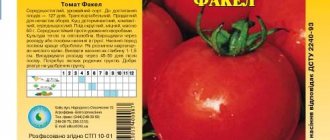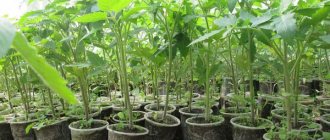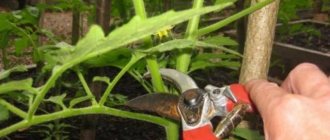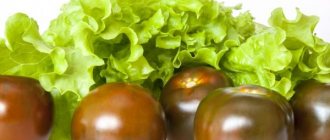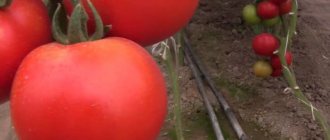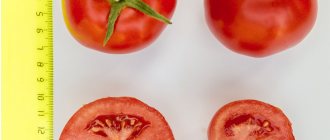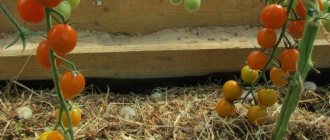Characteristics and description of tomato
Berberana is the development of Dutch breeders from the international company Enza Zaden. This is not the first crop of the company that Russian tomato lovers have appreciated. It is intended for breeding only in greenhouses: amateur and industrial.
Distinctive features
The bush is indeterminate, spreading, 1.5-1.8 m high. The foliage is medium, the leaves are dark green.
An early-ripening hybrid, 95-100 days pass from the moment of germination to full maturity.
Productivity is high, from 1 sq. m, 8-13 kg of fruits are collected, provided that 3 seedlings are planted per 1 sq. m. m. Ovaries are formed under any weather conditions, even unfavorable ones.
The hybrid is well adapted to high temperatures, which is important if the crop is grown in greenhouse conditions.
It has increased resistance to many diseases of the nightshade family, such as tobacco mosaic, cladosporiosis, fusarium, bronze spot, verticillium wilt.
Reference. The hybrid genes contain immunity to diseases of viral and fungal etiology.
The culture requires obligatory pinching and tying up of tall plants.
Fruit characteristics
The average weight of one fruit is 210-260 g. The shape is round, slightly flattened. The color is bright red, the taste is excellent, sweet with pleasant fruity notes, the flesh is juicy. The skin is dense, there are 4-6 seed chambers.
The purpose of ripe vegetables is universal. They are great for fresh consumption and do not lose their taste when processed into winter preparations.
Can be stored for 4 weeks without loss of external and taste properties. They withstand long-term transportation well.
The photo shows F1 Berberan tomatoes.
Characteristics of the variety
| Variety type | Variety |
| Bush type | Determinant |
| Soil type | Open ground, Film shelters |
| Precocity | Early ripening |
| Color | Red |
| Fruit weight | 15 g |
| Productivity | 3.5 kg/sq.m |
| Taste qualities | Fine |
| Application | Salads |
| Number of nests | 6 |
The Visibly Invisible tomato variety was developed through the efforts of Siberian scientists. It is characterized by early ripeness; the period from planting seeds to fruits ranges from 80 to 100 days. The bush of the plant is low-growing, spreading, the trunk is thick, the green mass is abundant. The leaf is dark green and has a regular shape.
How to grow seedlings
Sowing of seeds begins at the end of February or beginning of March. The tomato is a hybrid, which means you won’t be able to prepare the seeds for planting yourself. You will have to buy them every time.
Reference. Hybrids do not retain parental properties in subsequent generations.
Seed preparation
As a rule, purchased planting material does not need disinfection. The manufacturer takes care of this himself. The only thing that won’t hurt is to soak the grains in a growth stimulator to improve germination.
Reference. The most popular growth stimulants are Epin, Zircon and Kornevin.
To obtain the highest percentage of germination, the seeds must be carefully examined for external defects: they must be light in color, without bending or visible damage.
The emptiness of the grains is checked by placing them in a saline solution. To do this, dissolve 1 teaspoon of salt in a glass of water and drop the seeds there. Those that have floated to the surface are not suitable for sowing.
Container and soil
The soil mixture is made from garden soil, humus and wood ash. All components are thoroughly mixed and poured with a pink solution of potassium permanganate. This is how the prepared soil is disinfected.
The preferred option for sowing containers is peat pots. Hybrid seedlings tolerate picking difficultly and painfully. After this procedure, the sprouts do not grow for a long time. When grown in peat containers, sprouts do not need picking. In addition, when transplanting into the ground, seedlings are placed in holes along with peat pots, which dissolve in the ground without damaging the root system of young bushes.
Planting containers are filled halfway with soil, after placing some sawdust or small pebbles on the bottom as drainage . As the seedlings grow, the remaining soil is added to the container. This way young plants receive more nutrients.
Sowing seeds and caring for seedlings
Seeds are sown in individual containers in grooves 1.5 cm deep. After sowing, the soil on top is leveled, compacted and slightly moistened with warm, settled water (at least 22°C). Then the containers are covered with a thin film to create a greenhouse effect and left in a warm and well-lit room at a temperature of at least 23°C.
Reference. Throughout the entire growing season from the moment the seeds are sown, the crop needs bright light.
Water the seedlings as the top layer of soil dries with a tablespoon of warm, settled water along the edge of the containers. After watering, the soil is loosened superficially with a wooden stick or an ordinary fork.
After two true leaves appear, the seedlings are fed with liquid complex fertilizer. The first feeding is mandatory to strengthen the immunity of seedlings.
2 weeks before transplanting into the ground, seedlings begin to harden. To do this, it is taken out into the open air initially for 20-40 minutes, gradually increasing the time spent on the street to several hours. During the hardening process, it is important to protect the seedlings from drafts, which are detrimental to tomatoes.
Landing
The Berberana tomato has the disadvantage of being almost impossible to grow outdoors. But this type of tomato grows well both in film greenhouses in the southern regions and in industrial glass greenhouses with additional heating and lighting.
Seeds should be grown 55-65 days before planting seedlings in the soil. Late February or early March, depending on the region.
It is best to buy seeds in trusted specialized stores. This way you can avoid disappointment when the plant begins to grow and bear fruit.
The embryos begin to germinate by placing them on a napkin soaked in water. There is no need to add additional disinfecting compounds.
Growing seedlings
It is preferable to grow seedlings from the first generation.
It is recommended to sow the seeds in separate peat pots so that they can be easily replanted without damaging the root system.
For greater harvest abundance, provide additional lighting with fluorescent lamps. Regularly water the seedlings with warm water heated to 23-25 degrees.
When the first leaves appear, fertilize the soil for the first time.
This variety is difficult to tolerate diving. Therefore, sprouts are picked at the stage of the first two true leaves.
Landing in the ground
When the soil in the greenhouse warms up, then the seedlings can be transplanted into the ground. This usually happens in May - early June. Before planting, the soil is loosened and humus mixed with wood ash is added.
For 1 sq. meter of prepared soil, it is recommended to plant no more than 4 seedlings, at a distance of approximately 30 cm from each other, so that the plants do not interfere with each other either with their root system, or stems with leaves, or fruits.
Having planted the seedlings in the ground, regularly water them generously with warm, settled water.
Form a bush into one or two stems. The Berberana tomato variety is indeterminate, so to control the overly rapid growth of the plant, pinch the top of the trunk.
How to grow tomatoes
The seedlings are transplanted into protected soil in early or mid-May, focusing on the soil temperature, which should not be less than 15°C.
Landing
First, the soil is loosened and mixed with humus.
If tomatoes were previously grown in the greenhouse, it is better to replace and disinfect the top layer of soil. This agricultural practice increases the nutritional value of the soil and reduces the likelihood of fungal infections. Young tomatoes are transplanted into holes 15 cm deep. Before planting, a little wood ash is placed at the bottom of the hole.
Planting pattern: 50 cm – distance between seedlings, 55-60 cm left between rows. For 1 sq. m place 3-4 seedlings in a checkerboard pattern.
This method of planting allows young plants to receive the necessary amount of light and ventilation. Sprawling bushes require a lot of space for full growth and development.
After replanting, the soil is compacted, moderately moistened, loosened and hilled. Transplanted bushes adapt to new conditions within a week.
Berberana tomato care
Tomatoes are watered regularly 2 times a week, otherwise the accumulation of excess moisture will have a detrimental effect on the root system. Water moderately, exclusively with warm, settled water, strictly at the root. Water for irrigation is heated in barrels in the sun. The culture responds well to drip irrigation.
After each watering, the soil must be loosened, removing weeds with roots. To retain moisture, the beds are mulched. In addition, mulch protects the soil from pests from the insect world. Loosening the soil promotes better penetration of oxygen to the roots, which is necessary for the full development of plants.
Tomatoes are fed once every 2 weeks with liquid fertilizers based on potassium and phosphorus or organic matter. Mullein infusion is used as organic matter in a ratio of 1:10.
Features of cultivation and possible difficulties
Culture needs mandatory stepsoning. If you do not remove excess shoots, the plant will spend nutrients on the development of unnecessary branches, and not on the formation of ovaries.
The bushes are formed into 1 or 2 stems; it is with these indicators that the maximum amount of harvest is observed. If the plant grows excessively, pinch off the top of the plant.
The variety belongs to raceme tomatoes, which are usually tied to trellises. Fruitful branches are secured with soft ropes to prevent them from breaking off. Each cluster forms a large number of fruits, the weight of which the branches cannot withstand without fixation.
Diseases and pests
The hybrid is resistant to the main diseases of the nightshade family, so it is quite possible to get by with the usual preventive measures: moderate watering with control of soil moisture, systematic loosening of the soil to remove weeds and regular ventilation of protected structures.
It is also possible to spray plants with decoctions of onion peels, garlic and burdock. Such preventive measures not only prevent the spread of infections, but also protect the bushes from pest attacks. Spider mites are especially dangerous in a greenhouse, as they love greenhouse conditions, which are considered their habitat.
Mulching beds with straw or fish heads buried in the ground and crushed cloves of garlic helps against mole crickets. The mole cricket senses unpleasant odors from afar and tries to avoid them.
Treating the stem with a soap solution helps against aphids. If there are a lot of aphids, the whole plant is sprayed. The soap solution also protects against slug invasion.
Mustard bushes planted next to tomatoes can protect you from the Colorado potato beetle. The beetle is dangerous because its larvae, which the females leave on the inside of the leaves, also feed on the tomato crop. Therefore, when inspecting plants for pests, inspect the leaves on both sides.
Care
Abundant watering and fertilizing with organic and mineral substances or fertilizers based on potassium and phosphorus twice a month.
Minimal prevention with sprays against various agricultural pests and diseases.
Timely stepsoning.
Be sure to tie up both the trunk and branches.
Try to protect your tomato bushes from drafts. When tomatoes freeze, they develop a purple color on both sides of the leaves.
The nuances of growing crops in different regions
Tomatoes are intended for cultivation in any greenhouses, regardless of their size and coverage. The culture develops well in glazed, polycarbonate, film greenhouses. It is completely unsuitable for open ground, even in the warmest regions.
In regions with a warm climate, tomatoes are planted under film shelters; in cold areas, they are bred in glass greenhouses with additional heating.
To prevent the development of fungal spores, protected structures must be ventilated without creating drafts. A regular flow of fresh air destroys the pathogenic environment and makes conditions in the greenhouse less favorable for insect pests.
Important. To mark the growing point of tall plants, pinch the crown. In such cases, plants spend nutrients on the formation of fruits, and not on further growth of the stem.
Landing
The Berberana tomato has the disadvantage of being almost impossible to grow outdoors. But this type of tomato grows well both in film greenhouses in the southern regions and in industrial glass greenhouses with additional heating and lighting.
Seeds should be grown 55-65 days before planting seedlings in the soil. Late February or early March, depending on the region.
It is best to buy seeds in trusted specialized stores. This way you can avoid disappointment when the plant begins to grow and bear fruit.
The embryos begin to germinate by placing them on a napkin soaked in water. There is no need to add additional disinfecting compounds.
Growing seedlings
It is preferable to grow seedlings from the first generation.
It is recommended to sow the seeds in separate peat pots so that they can be easily replanted without damaging the root system.
For greater harvest abundance, provide additional lighting with fluorescent lamps. Regularly water the seedlings with warm water heated to 23-25 degrees.
When the first leaves appear, fertilize the soil for the first time.
This variety is difficult to tolerate diving. Therefore, sprouts are picked at the stage of the first two true leaves.
Landing in the ground
When the soil in the greenhouse warms up, then the seedlings can be transplanted into the ground. This usually happens in May - early June. Before planting, the soil is loosened and humus mixed with wood ash is added.
For 1 sq. meter of prepared soil, it is recommended to plant no more than 4 seedlings, at a distance of approximately 30 cm from each other, so that the plants do not interfere with each other either with their root system, or stems with leaves, or fruits.
Having planted the seedlings in the ground, regularly water them generously with warm, settled water.
Form a bush into one or two stems. The Berberana tomato variety is indeterminate, so to control the overly rapid growth of the plant, pinch the top of the trunk.
Harvesting and application
Depending on climatic conditions, fruit ripening varies in different regions.
The average time is 95-100 days, but in cold areas the harvest starts a little later. Ripening is uniform, in whole clusters, which greatly simplifies collection. It is not necessary to wait for vegetables to fully ripen; they are quite capable of ripening on their own at room temperature.
The purpose of the fruit is universal. They look great in summer salads and perfectly complement any vegetable and meat dishes.
They do not lose their taste in pickles, marinades, and preserves. They are used for processing into tomato products: juices, ketchups, adjika, pastes.
Ripe vegetables can be stored for 4 weeks without loss of taste. They perfectly withstand long-term transportation, maintaining their presentation.
One of the best early ripening varieties for the greenhouse is the Berberan F1 tomato: a detailed description of tomatoes
Berberana is a productive Dutch hybrid, revered among gardeners. Tasty, convenient, early - that’s how you can characterize this tomato.
| Height | Landing location | Ripening time | Fruit color | Fruit size | Origin | Fruit shape |
| Tall | Greenhouse | Early ripening | Reds | Average | Hybrid | Flat-round |
Description and characteristics of the variety
The Berberana tomato is an indeterminate hybrid, tall and robust. Powerful shoots reach 1.6-1.8 m in height. Tomatoes ripen early - 95 days after germination.
At the break, the flesh is fleshy and juicy. Fruits of universal use:
- fresh salads, slices;
- preservation of slices and whole tomatoes;
- sauces, ketchups, juices.
Advantages and disadvantages
- resistance to mosaic and spotting, cladosporiosis and verticillium;
- early ripeness;
- amicable maturation;
- tolerance to drought and heat;
- high yield.
Minuses:
- need for feeding;
- the need for formation.
Features of cultivation and storage
Planting of seeds begins in early to mid-March. The seed material is soaked in a layer of gauze until seedlings appear for 4-5 days. Choose light, fertile soil for containers, add compost, peat, and ash. For disinfection, pour boiling water or 1% potassium permanganate.
Features of growing seedlings:
- keep the boxes until germination at 22-24 °C;
- harden young seedlings at 14-15 °C;
- irrigate with a spray bottle;
- dive with 3 true leaves;
- feed 2 times with guamate before and after picking, 10 days later.
Advantages and disadvantages
Positive qualities of the Dutch tomato:
- high resistance to diseases;
- high fruiting rate;
- ease of care;
- excellent adaptation to high temperatures;
- excellent taste of fruits;
- amicable maturation;
- versatility in cooking;
- long-term maturation;
- long transportations.
Some negative sides:
- the possibility of breeding only in protected structures;
- Garter required;
- stepsoning required;
- the impossibility of independently selecting seeds for the next planting.
Care
After transplanting tomatoes, standard procedures are performed, which include:
- Watering. The soil should be irrigated in a timely manner, since nightshades do not tolerate waterlogging or drought. In practice, gardeners water plants with warm water once every 7 days. Reference! Be sure to reserve water for watering any variety of pepper tomatoes.
- Loosening. It is carried out approximately once every 14 days to moisten the soil and increase its fertility and air supply.
- Fertilizers and fertilizing. Try to add nutrients (organic fertilizers, minerals and complex mixtures) necessary for the growth and development of plants. They should be applied no earlier than 10 days from the date of planting. The total number of preventive procedures should be no more than 3 times per season.
- Stepsonning. Get rid of shoots and excess leaves that are located at the bottom of the plant. This method helps to form tomatoes into 1-2 stems. The frequency of pinching depends on the type of variety.
Farmer reviews
Gardeners leave positive reviews about the taste of ripe vegetables.
With proper care, they grow sweet, juicy, with pleasant fruity notes. Often, lovers of Dutch selection breed two tomato hybrids on their plots - Mahitos and Berberana - to understand which is better. These hybrids have similar growing conditions and fruiting characteristics. The main difference between Machitos: in warm regions it is transplanted from greenhouses to open beds, and a double harvest is collected. Reviews from gardeners about Dutch culture:
Ekaterina, Kislovodsk: “I plant two tomatoes at once, Makhitos and Berberana. The first one is more capricious, requires more light, but in general it is easy to care for. Both types have excellent taste, excellent fruiting, and versatile vegetables. I tie him up, feed him, and feed him. I grow both tomatoes only under film cover. Dutch varieties are the best. It's a pity that you have to buy seeds every time. It's good that the price is affordable."
Stepan, Yaroslavl: “The yield is excellent. True, there were some minor difficulties in the process. The brushes hung down to the ground, so we had to install additional supports. The tomatoes were large, weighing up to 400 g. Very tasty and aromatic. Doesn’t get sick and doesn’t require much trouble.”
Care
Despite the fact that the trunk of the plant is very strong, it is still advisable to tie it up as necessary. But you can do without it. But the branches that hold heavy fruits must be strengthened with pegs or other supports.
The formation of a bush in a greenhouse takes place in 3 stems by pinching, and in the conditions of balcony plant life - in 2 branches.
Plant diseases
“Apparently invisible” is quite resistant to various diseases. However, it can still be affected by bacterial black spot. Special preparations that can be purchased in specialized stores will help cure the plant from this disease.
In case of fruit rotting, the bush is treated with a solution of calcium nitrate and at the same time the volume of watering is reduced.
The “Apparently Invisible” tomato variety is very versatile. Caring for it is simple and does not require deep knowledge of agriculture. Thanks to this, it can be recommended to both experienced summer residents and beginners.
Excellent tomatoes for low greenhouses on video
If you have grown Berberan F1 tomatoes, please write whether you liked them or not. What was the yield and taste of the fruits like under your climatic conditions? How do you rate the disease resistance of this hybrid? Briefly describe the advantages and disadvantages of this tomato in your opinion. If possible, attach a photo of your tomatoes to your comment. Thank you!
Your feedback on the Berberan tomato and additions to the description will help many gardeners evaluate this variety more objectively and decide whether it is worth planting or not.
Tomatoes "De Barao": description of the variety and growing technology
Description of the variety
Variety characteristics:
- Minuses:
- high cost of seed material;
- greenhouse crop, absolutely not suitable for growing in open ground.
Sowing time
Whatever soil is used when growing tomato seedlings, it must be disinfected. The most effective and affordable way is to use biological fungicides - “Fitosporin”, “Gamair”, “Glyokladin”. Also, to prevent diseases and pests, the soil is calcined at high temperatures (there is a high probability of destruction of nutrients), frozen (labor-intensive), and steamed.
Tomatoes "De Barao" belong to indeterminate varieties. Such tomatoes are always tall and deservedly enjoy extreme popularity among gardeners in our country.
The variety "De Barao" is an indeterminate type, with a standard vine height of three meters, and sometimes more. Tomatoes of this variety can be cultivated both in a greenhouse and in open ground. Tomatoes "De Barao" belong to the varieties of the mid-late ripening period.
The mass stage of fruiting begins from the 115th day after sowing the seed material. Tomato bushes are medium-sized, capable of forming lateral shoots well and have characteristic long internodes.
The leaves have a dark green color. As a rule, the foliage is medium in size. The inflorescences are simple and quite compact. Most often the first inflorescence is formed at the 9th or 11th leaf level, but there may be slight variations depending on the variety. The next inflorescences are formed three leaves after the first.
The popularity of De Barao tomatoes among gardeners is due not only to their excellent taste, but also to a fairly simple growing technology. In addition, the variety has a number of advantages that distinguish it favorably from other varieties and hybrids:
- the possibility of universal use of the harvested crop;
- high yield per square meter;
- unpretentiousness and resistance to diseases;
- uniformity and visual attractiveness of tomatoes;
- excellent taste and balanced composition of tomato pulp.
READ MORE: Tomato Niagara: characteristics and description of the variety, reviews, photos, yield, video
The variety is quite unpretentious and requires compliance with the basic rules of agricultural technology when growing on a personal plot.
The De Barao tomato variety, depending on the color of ripe fruits, is divided into several varieties that have the same properties, including high growth and an indeterminate type, which involves the formation of a new ovary as it develops, with an extension of the fruiting period.
| Variety name | Features and characteristics | Productivity |
| Black De Barao | It is cultivated in garden plots and small farms using film covers. It is used fresh and for whole-fruit canning. Late-ripening, indeterminate, highly branched variety, the height of which exceeds two meters. The first inflorescence is above the 9-11th leaf. Tomatoes are ovoid in shape, with a smooth surface. The color of ripe fruits is purple-brown. The weight of the tomato is about 60 g. The taste is good. | up to 8 kg per square meter |
| Red De Barao | A mid-late indeterminate variety intended for fresh consumption, canning and long-term storage. The taste and product quality are excellent. The main advantages are cold resistance, shade tolerance and duration of fruiting. The color of the fruit is red. The shape is oval-ovoid. Average weight 65 g. The pulp is fleshy. Transportability is good. | 3.5 kg per tomato bush |
| Pink De Barao | A mid-late variety, intended for fresh consumption, canning and long-term preservation. The taste and product quality are excellent. The main advantages are excellent ripening, long-term storage without loss of quality, and resistance to late blight. The fruits are pink, oval-ovoid, dense. Average weight is 65 g. Transportability is very good. The bushes are powerful, vigorous, indeterminate. | from 5.5 – 7.0 kg per square meter |
| Royal De Barao | Mid-late ripening. Designed for fresh and canning tomatoes. The taste and marketability are excellent. The main advantages are cold resistance, shade tolerance and long-term fruiting. The variety is resistant to late blight. The color of the fruit is soft crimson, with an oval-plum shape. The pulp is relatively dense and fleshy. The average weight of the fetus varies from 0.1 to 0.15 kg. | up to 15 kg from one bush |
| Golden De Barao | Medium late ripening. Designed for fresh and canning tomatoes. The taste and marketability of the fruits are good. The variety is resistant to late blight. The fruits are yellow, dense, oval-ovoid in shape, weighing from 60 to 90 g. The bushes are very powerful. | up to 4 kg per plant or 8 kg per square meter |
| Yellow De Barao | Tomatoes with an extended growing season. During the cultivating process, fairly tall and well-formed bushes are formed. The weight of each fruit is about 80 g. The fruits are elongated, yellow in color, with dense and tasty pulp. Transportability and appearance are excellent. | 6.5 kg per bush |
According to most experts, the best predecessors for any varieties and hybrids of tomatoes are cucumbers, zucchini, carrots, cauliflower, parsley and dill.
It is recommended to sow seed material in March. For this purpose, you should prepare a planting container and fill it with nutritious soil substrate. Sowing De Barao seeds should be carried out in accordance with the following rules:
- the soil mixture should consist of half a bucket of ordinary garden soil with the same amount of leaf or manure humus;
- prepared seed material should be sown on a layer of moistened soil at a distance of 1.5-2 cm;
- A nutrient soil mixture should be poured on top of the seeds placed on the soil in a layer of no more than 0.8 cm.
Sowing should be covered with film or glass to warm it up and retain moisture. The container with the sown seeds should be placed in a warm place. The crops are systematically ventilated.
Growing seedlings
Caring for tomato seedlings is not difficult, but it requires certain knowledge and time. Usually the first tomato seedlings appear already on the fifth day. Further care for seedlings is standard and consists of the following activities:
- when shoots appear, the film is removed from the container;
- temperature readings should be at 15°C in the first days;
- from the second week of development, the temperature should be raised to 20°C;
- the seeds remaining on the leaves are removed by hand after spraying the plants with plain water from a spray bottle;
- in case of insufficient lighting, additional illumination of plants should be carried out;
- fertilizing should be carried out with complex mineral fertilizers or vermicompost three weeks after emergence;
- picking is carried out in the phase of a pair of true leaves on the plants;
- To protect against blackleg, you need to dust the soil with regular wood ash.
If these simple requirements are met, it helps to obtain strong and very healthy tomato seedlings. Before planting, measures should be taken to harden the seedling material.
Planting of seedlings can be done both in greenhouses or hotbeds, and on open ground ridges. Planting of De Brao tomato seedlings, depending on the cultivation region and weather conditions, can be done in mid-May under film covers and in greenhouses, and in early June, seedlings are planted in open ground.
The seedlings must be two months old and have at least 5 true leaves. The scheme for planting seedlings is 50 x 55 cm. It is necessary to tie the growing plants to stakes. After planting, the holes are watered with plenty of warm water.
Rules of care
“De Barao” is a tall variety of tomatoes, which requires not only to be planted in an area where the plants will receive the maximum amount of sunlight and heat, but also to properly care for the tomatoes.
Watering and fertilizing
Tall tomatoes should be watered only at the root; fruits and leaves should not be wetted during watering.
The root system of this tomato variety grows and develops very well, as a result of which it is necessary to carry out regular and abundant watering. For good growth, tomatoes need 2.5 liters per plant daily.
After watering, the soil between the rows must be loosened. The use of a drip irrigation system for plants makes the watering procedure easier.
During the summer, you should feed the plants three times with a solution of the Baikal-EM-1 product.
As a rule, it is recommended to form De Barao tomatoes into one or a pair of stems. Pinching is an extremely important and necessary procedure when growing tall varieties and hybrids of tomatoes. All excess stepsons must be removed.
After the first tomato fruits have formed in the lower part of the plant, it is necessary to remove the lower leaves, leaving no more than eight on the upper part of the plant. As new leaves grow, the lower ones should be removed.
You may also be interested in an article in which we talk about the technology of growing tomatoes upside down.
